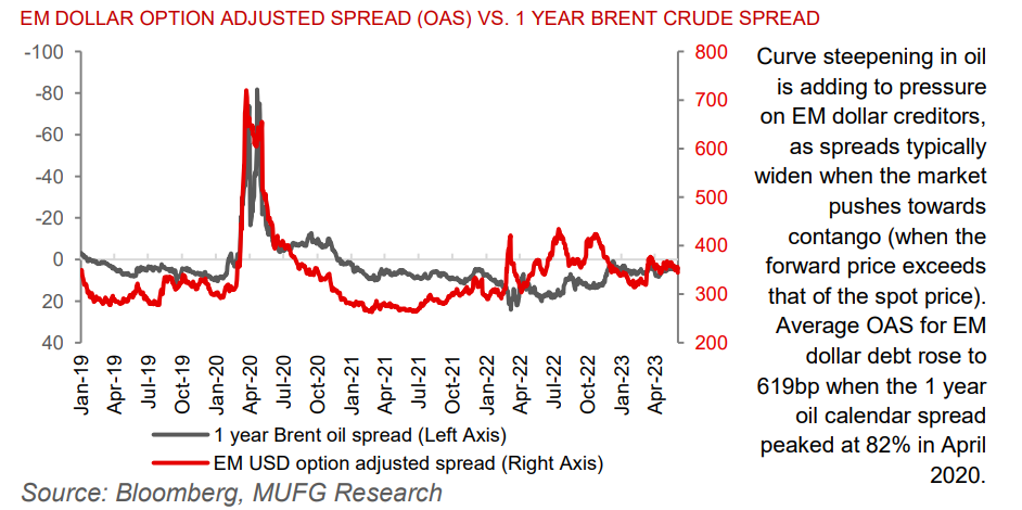Examining tepid Chinese activity and sluggish commodity prices across EMs
EHSAN KHOMAN
Head of Commodities, ESG and
Emerging Markets Research –
EMEA
DIFC Branch – Dubai
T:+971 (4)387 5033
E: ehsan.khoman@ae.mufg.jp
RAMYA RS
Analyst
DIFC Branch – Dubai
T:+971 (4)387 5031
E: ramya.rs@ae.mufg.jp
LEE HARDMAN
Senior Currency Analyst
Global Markets Research
Global Markets Division for EMEA
T: +44(0)20 577 1968
E: lee.hardman@uk.mufg.jp
PAUL FAWDRY
Head of Emerging Markets FX Desk
Emerging Markets Trading Desk
T: +44(0)20 577 1804
E: paul.fawdry@uk.mufg.jp
MUFG Bank, Ltd.
A member of MUFG, a global financial group
Macro focus
Tepid Chinese activity data and sluggish commodity prices have continued to weigh on the EM complex in recent weeks. Of the two, EMs are more exposed through the commodity price channel (notably oil) with ~40% of exports being commodities, whilst ~15% of exports for EMs going to China. Currently, however, oil prices are not at levels that tend to have a significant impact with our examination suggesting that the sensitivity of EM sovereigns’ USD bond spreads to oil prices is non-linear, that increases markedly only when Brent oil drops below USD60/b, whereas the impact becomes negligible with oil prices above USD80/b (see here). There are however distinctions across the EM complex, with investors looking for tail hedges against a further drop in oil prices, investment grade oil exporters may offer an inexpensive value proposition.
FX views
The performance of emerging market currencies has been more mixed over the past week as the USD has lost some upward momentum more broadly. This has coincided with the USD and US yields losing upward momentum following comments from Fed Governor Jefferson signalling that the Fed leadership is more inclined to slow the pace of hikes by skipping the June meeting. Meanwhile, policymakers in Turkey have been allowing the TRY to depreciate at a much faster pace since the elections have passed. It has resulted in USD/TRY quickly jumping above the 21.000-level at the start of this week. It fits with our outlook for catch up TRY weakness after a period of more controlled and gradual depreciation in the run up to the election.
Trading views
Turkey has stolen the limelight once again in EM with a 5% nominal depreciation in the last week outstripping the already very high 2.5% that was priced in by the forwards. Once again Turkey is doing things in its own particularly way by having a sharp currency depreciation alongside a positive rerating in its credit and macro outlook. More broadly, carry trades are having their best year on record so far. Like we have said previously this seems really at odds with where we are in the US rate cycle. It though speaks more to low vol environment than actual expectations on individual country prospects.
Week in review
Inflation in Poland came in lower than expected but core remained elevated with rates likely to remain on hold until 2024 (see here). Economic growth in Turkey came in stronger-than-expected in Q1 2023 with robust domestic demand despite the impact of the earthquake. Finally, the EM EMEA aggregate PMI remained flat in May (on a PPP-weighted basis), but remaining above its long-term average.
Week ahead
This week, we have rate meetings in Poland (MUFG and consensus on hold at 6.75%) and Russia (MUFG and consensus on hold at 7.50%). Additionally, Q1 GDP and BoP data will be published in South Africa.
Forecasts at a glance
Whilst EMs continue to grapple with much the same themes at the turn of the year, we view the outlook as a tale of two halves in 2023. A fading boost from reopenings, a global manufacturing cycle downturn and tighter financial conditions are lumpy headwinds that will weigh on EM prospects in the first half of 2023. However, China’s zero COVID policy exit, the eventual end of rate hikes and a US dollar peak, all offer significant tailwinds to the EM complex in the second half of 2023 (see here).
Core indicators
According to IIF data, weekly inflows to EM assets in the form of equity totalled USD1.1bn, while the EM bond investors remained net sellers for the third consecutive week.
CHART OF THE WEEK: CRUDE OIL SPREADS CAST SHADE ON EM CREDIT

